How to Make Pita Bread
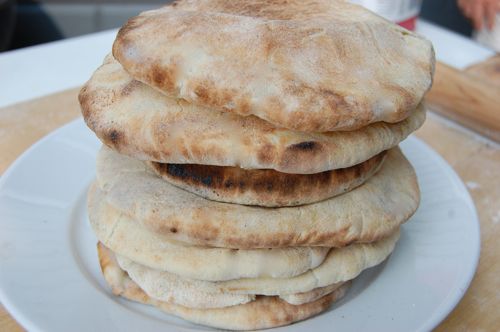
Now that’s what I call a big ol’ pile of fresh-baked goodness. For a summertime mezze (Middle Eastern appetizer) party, homemade pitas can’t be beat. Sheesh! There I go getting all Martha Stewart on you again. Plain old chicken salad sandwiches work great on them, too.
One of the really nifty things about pitas is that you don’t need a good oven — or even an oven at all — to make them. They work in everything from a brick oven to a cast iron skillet. Which means there’s really no excuse not to try them. Start by combining your ingredients, save for the water, in the bowl of a mixer fitted with a paddle.

Stir the ingredients on low, then add the water, stirring about 30 seconds more until the ingredients are moistened and the dough comes together.
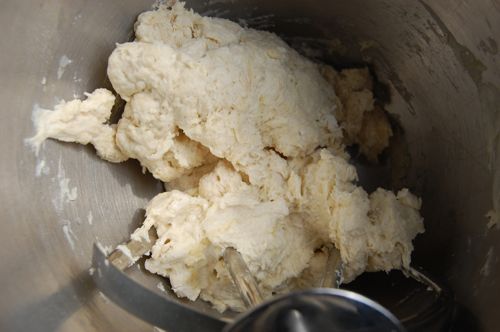
Switch to the dough hook and knead for 5-7 minutes until the dough is elastic and a somewhat sticky. Can you do all this by hand? Of course, yes.
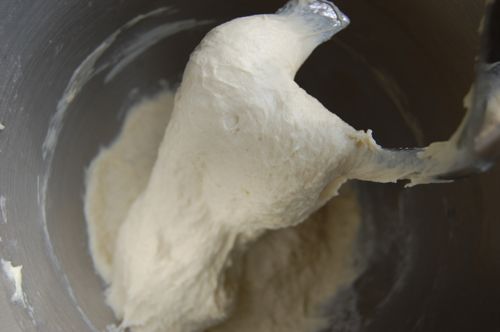
Turn the dough out into an oiled bowl and let rise for an hour, or put it in the fridge, covered with plastic wrap, overnight. If you decide on the latter (and I recommend it), it’s a good idea to de-gas the dough by pressing down on it with your palm once or twice in the first 4-6 hours of chilling.
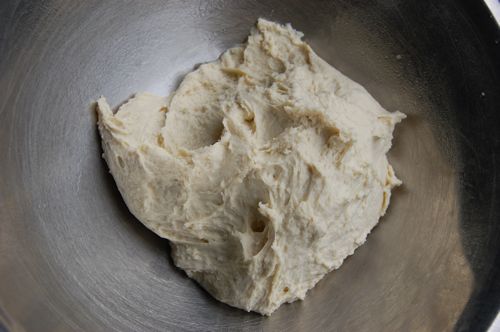
The next day, remove the dough from the fridge (here it’s got my big ol’ hand print on it), and remove to a floured board.
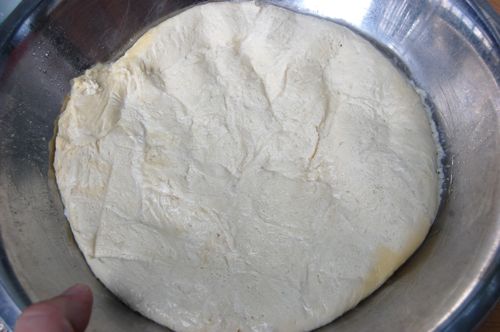
Cut the dough into nine 3-ounce pieces…
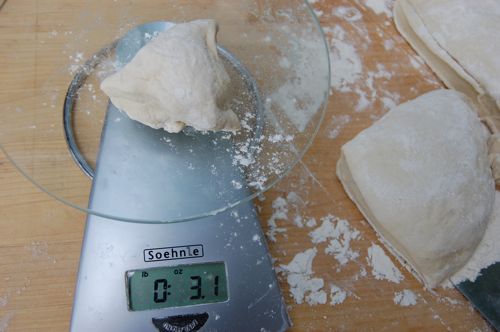
…and roll them into balls.
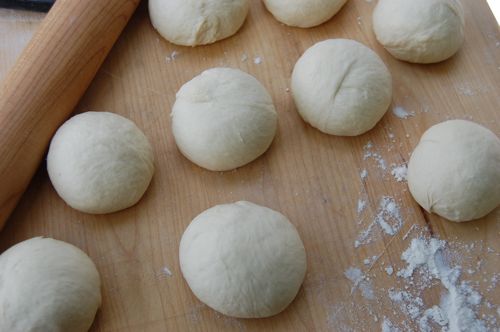
Let the dough balls rest for 20-30 minutes, then apply your pin and roll.

You want a rough circle about seven inches across. Once rolled, let the dough circles rest about 10 – 15 minutes.
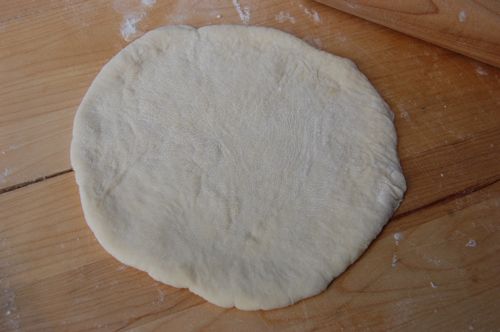
All you need to do now is apply them to a hot baking surface. That can be a baking stone in a 550 oven, a cast iron skillet that’s been pre-heated over a medium-low flame, or— ehem — a big brick oven. Guess which one I’m using? Simply place the dough circle on your device…
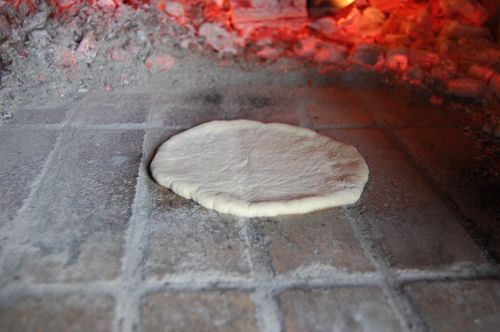
…and after a minute or two — depending on the heat — it’ll puff up into a little pillow. Once it’s puffed, you can turn it. I recommend it for brick oven bakers (since brick ovens are so hot…use the longest tongs you own) as well as for skillet bakers. Home oven bakers can simply let them bake without turning to the desired degree of doneness.
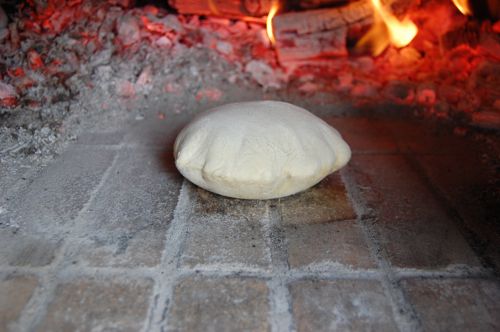
If you plan to split the pitas to make pocket sandwiches, I suggest a very light bake, until there’s just a hint of brown on the bottom. Otherwise, bake them to whatever degree you wish. Obviously I like mine a little more well done. The brick oven chars them if I’m not careful, though soot-dusted pitas are their own rustic pleasure. You really can’t go wrong.
Why won’t my pitas puff up nicely like in your pics? I used your sourdough pita recipe with half white half whole wheat flour. I cooked them on a tawa (sp?)on my stove top. A tawa is a large, flat piece of metal used by the Indian community in Trinidad to cook roti on.
The first time I tried them only two or so out of the batch puffed up nicely. The second time…none. It isn’t that they don’t puff at all. Sometimes only half of it will or small patches will bubble.
Any ideas?
Hi Jackie! My suggestion is to try the oven instead. The hot environment will help dry the top crust and make it more rigid, more likely to lift off. If that doesn’t work get back to me and we’ll try something else. Good luck! – Joe
I tried your suggestion and they puffed up like a dream. However I found that they took forever to brown and I missed the little burned/charred bits I got from cooking them on the stove top. The burny bits taste best to me.
I think I’ll stick to the stove and try to use a heavy pot or something to cover them while they’re cooking to see if I can get them to puff.
Thanks!
Jackie
Best of luck with those! Let me know when you’ve produced your ideal pita, because I’m sure others will be interested in the method. Cheers. – Joe
I have tried making pita several times, finally it worked, thanks to you.
So glad to hear it, Kathleen! Thanks so much for the note!
Any advice for pitas on the grill? I know I’m late to the party here, but I just discovered you!
I’m hoping for easy summer bread without heating up the kitchen. Top down, top up? Direct or indirect heat? It’s a gas grill, but I sucessfully do pizza on a regular basis.
Great idea, Ann! A pizza stone right on the grill is the best way to go. Could you swing that? Otherwise don’t put them right over the coals. Let them “bake” away from direct heat. Have fun and let me know how it goes!
– Joe
Has anyone tried the pizza stone on the stove top? Seeing as the hot stone was the original way I was wondering how that would turn out.
Hey Anthony! My feeling is that you need the oven heat as well, but I could very easily be wrong about that. Try it and port back, please, because I’ll be interested.
– Joe
Hey Joe these are the bomb, not sure if you take requests but i was wondering if you had a recipe for pita that i can’t seem to find. You know when you get a street gyro, or at some high end greek places the pita seems to be more uniformly round, its a flat pita not stuffed (they wrap the pita around the filling not stuff it) and it will usually have grill marks on it and may even be a bit oily? It seems to be an entirely different type of pita/flatbread however I have had it many times in many parts of the country so I’m assuming there is a specific style or recipe that that falls into? You know where I’m goin with this or am i too far out there?
Hey Jake!
I know exactly what you mean. Those are nothing more than focaccia dough rolled thin and baked on a stone. They’re fun to make but remember to use a lot of flour because they stick! If you want to use my focaccia dough, add an extra cup (5 ounces) of flour to the formula to give it a little more body!
Cheers and have fun!
– Joe